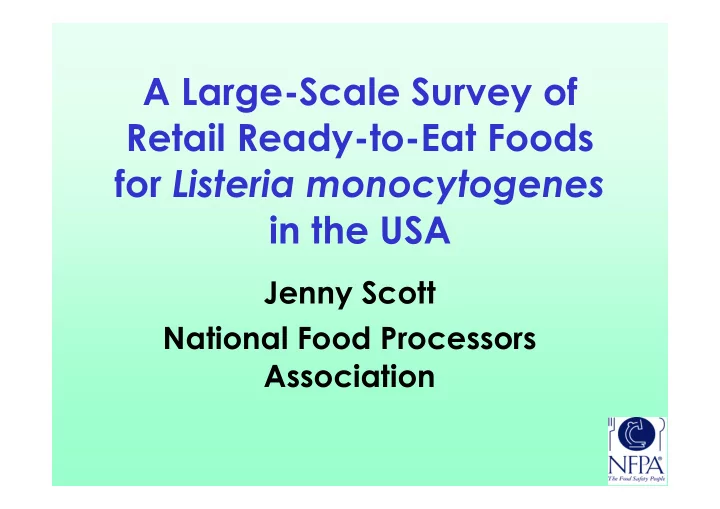

A Large-Scale Survey of Retail Ready-to-Eat Foods for Listeria monocytogenes in the USA Jenny Scott National Food Processors Association
Why? • Industry desired to change US policy – “zero tolerance” • Ready-to-eat foods containing detectable levels deemed adulterated • Recognized the need for a risk assessment to set appropriate risk management strategies • Determined that lack of data (prevalence and numbers) was impediment to conducting the needed risk assessment
Project Objectives 1) Quantify the levels of Lm in certain foods in order to estimate actual consumer exposure to the organism 2) Identify the subtypes of Lm in those foods and compare them with the clinical subtypes from the same geographic area
Project Objectives 3) Use the quantitative exposure data with illness data collected among consumers in the same geographic region to conduct a risk assessment to determine the impact of the number of Lm consumed on the risk of listeriosis
NFPA RF- Listeria Project • The project team – David Gombas, Yuhuan Chen, Jenny Scott et al. – expert consultations – industry, FDA, FSIS, Health Canada • Overall objective: obtain data to support science-based policies • Retail survey and risk assessment – 3 yr/$1.4 M project
Approach ÿ Collect data on Lm populations in retail foods likely to contribute to consumer exposure – products with relatively high Lm prevalence – products frequently consumed in test location – products not likely to be further treated
Approach ÿ Perform data collection in location where illness data are reliable – CDC active surveillance for Lm in FoodNet Sites – Case control studies planned for 2000- 2001 – Clinical isolates could be available for subtyping
Approach ÿ Selected sliced luncheon meats (ham, bologna, poultry) and prepared “deli” salads (e.g., potato, tuna) ÿ Selected Northern California and Maryland
Number of Samples • Determined statistically • Large numbers (2500-10,000) needed to give 95% confidence of actual percentage positive • Trade off between the desired confidence in the estimate and what was practical
Products Collected and Tested January 2000 – November 2001 • Luncheon Meats (e.g., sliced ham, bologna, poultry) • Deli Salads (e.g., tuna, potato, pasta, coleslaw)
Products Collected and Tested October 2000 – November 2001 • Fresh Soft Cheeses (e.g., queso blanco) • Bagged, Precut Leafy Vegetable Salad • Blue-veined and Soft Mold-ripened Cheese (BVMRC) • Seafood Salads (other than tuna) • Smoked Seafood (To develop exposure data for FDA Lm risk assessment)
Project Protocol 100 or 25 samples per category/site/week
Prevalence, Enumeration tests • Detection sensitivity: 1 cfu Lm in 25 gm • Enumeration range: 0.3 – 3x10 5 /gm Data reported to NFPA: • +/- for each sample , by product type and FoodNet site • Lm levels in Lm -positive samples • Additional information for FDA samples Lm isolates archived for subtyping: – Ribotyping, lineage (Cornell Univ.) – PFGE, serotype (USDA ARS)
Results of the Retail Survey
Summary of Results Summary of Results • Prevalence of Lm was generally low – 577 positive of 31,705 samples (1.82% prevalence) – 0.2-4.7% • Numbers of Lm were generally low – In 402 of the 577 positive samples the numbers were <0.3 MPN/g
31,705 Samples Tested in 2000-2001 No. Positives (No. Samples Tested) Products MD CA MD+CA Fresh Soft 4 (1450) 1 (1481) 5 (2931) Cheese Bagged 8 (1465) 14 (1501) 22 (2966) Salads BVSMR 7 (1473) 30 (1497) 37 (2970) Cheese Seafood 88 (1225) 27 (1221) 115 (2446) Salads Smoked 43 (1281) 71 (1363) 114 (2644) Seafood Luncheon 54 (4599) 28 (4600) 82 (9199) Meats Deli 103 (4293) 99 (4256) 202 (8549) Salads
0 1 2 3 4 5 NFPA RF F r e s h C S h 0.2 o e f e t s e Bagged Salad 0.7 BVSMR Cheese 1.3 S e a f o 4.7 o S d a l a d S m o k S e e d a 4.3 f o o d Luncheon 0.9 Meat % positive D e l i 2.4 S a l a d
Contamination Levels of Lm When Detected <0.3 0.3-10 >10-100 >100 180 160 140 120 100 80 60 40 20 0 BV Sm BS FS SS L DS Ch S Ch M
Contamination Levels of Lm When Detected >10-100 >100 9 8 7 6 5 4 3 2 1 0 BV Sm BS FS SS LM DS Ch S Ch
Publications: JFP 66(4): 559- 569 and 570-577. 2003 1. Survey of Listeria monocytogenes in Ready-to-Eat Foods David Gombas, Yuhuan Chen, Rocelle Clavero, Virginia Scott 2. Listeria monocytogenes : Low Levels Equal Low Risk Yuhuan Chen, William Ross, Virginia Scott David Gombas
Next Step: Dose-Response in Relation to Genetic Subtypes • Ribotype, Lineages (Cornell Univ.), PFGE, serotype (USDA ARS) – Prevalence/concentration in food isolates – Prevalence in human isolates • Use subtype and enumeration data – Subtype-specific risk assessment
Acknowledgements • Funding – USDA CSREES, – FDA (JIFSAN) – Industry partners • Technical assistance – William Ross – Robert Blodgett, Jerome Schneidman Wallace Garthright
Recommend
More recommend